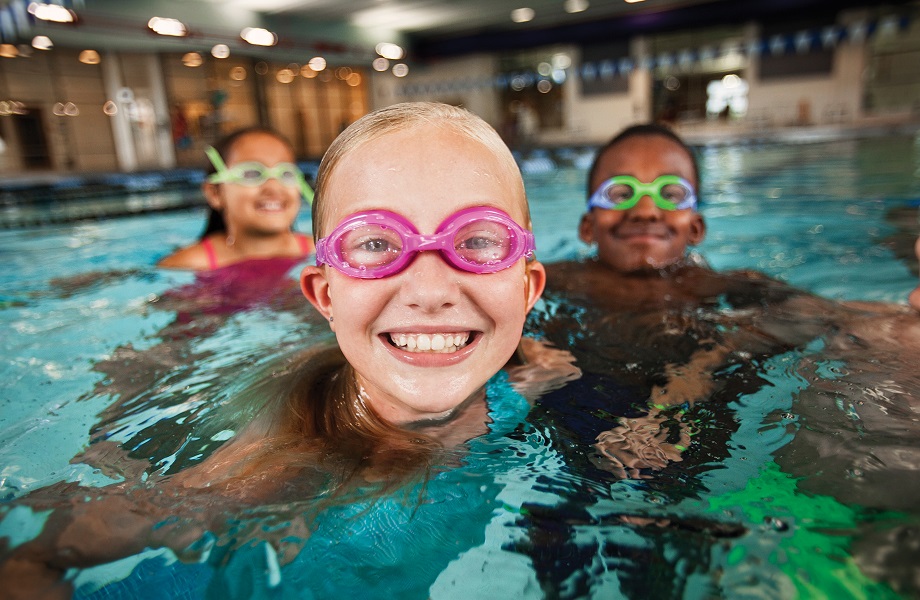
Ages 6 Months to 12 Years
At the YMCA, we believe swimming is more than just fun—it’s a life-saving skill. Our swim lessons teach kids of all ages and abilities water safety while building confidence and a lifelong love of swimming.
Swimming goes far beyond the fun of the splash zone or the excitement of learning to dive. At the YMCA, we believe that knowing how to swim and being water safe is a crucial life skill that everyone should have. So, our swim lessons introduce youth of all ages to the joy and fun of swimming, but also help develop a life-long love of water and a healthy appreciation for water safety.
How Our Curriculum Works
Placement is based on a child’s age and swimming ability:
- 6 months to 3 years: Parent & Child Swim Starters (Stages A & B)
- 3 to 5 years: Preschool Swim Basics (Stages 1–3)
- 6 to 12 years: School Age Swim Basics to Swim Strokes (Stages 1–6)
Click on an arrow below for more information on each level.
Swim Starters (Ages 6 months-3 years)
Build water confidence alongside a parent in the pool.
-
- Stage A – Water Discovery: Introduces infants and toddlers to the water through fun, confidence-building activities. Progress to Stage B when students respond to verbal cues, can jump on land, and are at least 2 years old.
-
- Stage B – Water Exploration: Explores body position, floating, bubbles, and basic safety skills. Move to Stage 1 when students can work with an instructor independently and are at least 3 years old.
Preschool (For Ages 3-5)
Develop foundational swimming and safety skills.
Key swimming benchmarks for Stages 1 – 3 (Swim Basics) include:
-
- Stage 1 – Water Acclimation: Focuses on underwater exploration and exiting the water safely. Progress to Stage 2 when students are comfortable going underwater and can float or glide with assistance.
-
- Stage 2 – Water Movement: Builds body control, directional change, and forward movement. Move to Stage 3 when students can float and glide independently for at least 5–10 feet.
-
- Stage 3 – Water Stamina: Introduces rhythmic breathing and integrates arm and leg movements. Progress to Stage 4 when students can swim 10–15 yards independently.
Focus on advanced technique and endurance.
-
- Stage 1 – Water Acclimation: Focuses on underwater exploration and exiting the water safely. Progress to Stage 2 when students are comfortable going underwater and can float or glide with assistance.
-
- Stage 2 – Water Movement: Builds body control, directional change, and forward movement. Move to Stage 3 when students can float and glide independently for at least 5–10 feet.
-
- Stage 3 – Water Stamina: Introduces rhythmic breathing and integrates arm and leg movements. Progress to Stage 4 when students can swim 10–15 yards independently.
-
- Stage 4 – Stroke Introduction: Learn front crawl, back crawl, and basic breaststroke and butterfly kicks. Move to Stage 5 when students can swim 15 yards of elementary backstroke, front crawl, and perform basic breaststroke and butterfly kicks.
-
- Stage 5 – Stroke Development: Develop major competitive strokes with an emphasis on water safety. Progress to Stage 6 when students can swim 50 yards continuously and 25 yards of proper front crawl, sidestroke, elementary backstroke, and breaststroke.
-
- Stage 6 – Stroke Mechanics: Refine competitive stroke techniques and explore competitive swimming skills.
Our progressive swim lessons build on water safety skills developed in Stages 1 – 3 before advancing to stroke development in Stages 4 – 6.
Key swimming benchmarks for Swim Basics Stages 1 – 3 include:
-
- Swim, Float, Swim – Sequencing a front glide, rolling to a back float, returning to a front glide, and exiting the water.
-
- Jump, Push, Turn, Grab – Developing skills to jump into the water, turn around, and safely reach the edge.
Key swimming benchmarks for Swim Strokes Stages 4 – 6 include:
-
- Develop Stroke Technique – Learn basic stroke techniques for front crawl, back crawl, breaststroke, and butterfly.
-
- Build Endurance – Participants will improve their endurances through stroke development, physical conditioning, and practice.
-
- Learn the Basics Competitive Swimming – Participants will learn the proper techniques for starts, strokes, and turns, building a strong foundation for future swim team participation.